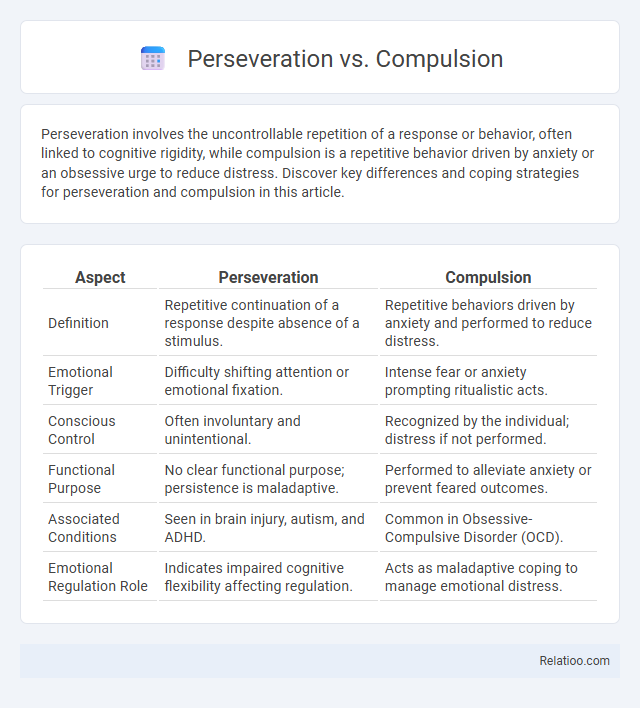Perseveration involves the uncontrollable repetition of a response or behavior, often linked to cognitive rigidity, while compulsion is a repetitive behavior driven by anxiety or an obsessive urge to reduce distress. Discover key differences and coping strategies for perseveration and compulsion in this article.
Table of Comparison
| Aspect | Perseveration | Compulsion |
|---|---|---|
| Definition | Repetitive continuation of a response despite absence of a stimulus. | Repetitive behaviors driven by anxiety and performed to reduce distress. |
| Emotional Trigger | Difficulty shifting attention or emotional fixation. | Intense fear or anxiety prompting ritualistic acts. |
| Conscious Control | Often involuntary and unintentional. | Recognized by the individual; distress if not performed. |
| Functional Purpose | No clear functional purpose; persistence is maladaptive. | Performed to alleviate anxiety or prevent feared outcomes. |
| Associated Conditions | Seen in brain injury, autism, and ADHD. | Common in Obsessive-Compulsive Disorder (OCD). |
| Emotional Regulation Role | Indicates impaired cognitive flexibility affecting regulation. | Acts as maladaptive coping to manage emotional distress. |
Understanding Perseveration and Compulsion: Key Differences
Perseveration involves the uncontrollable repetition of a response or behavior, often due to cognitive rigidity or neurological conditions, while compulsion is characterized by repetitive actions driven by an urge to reduce anxiety or prevent a feared event, commonly seen in obsessive-compulsive disorder (OCD). Understanding these key differences helps you recognize that perseveration stems from difficulty shifting cognitive sets, whereas compulsions are performed with a conscious intent to alleviate distress. Accurate identification of perseveration versus compulsion is crucial for effective treatment strategies and improving your daily functioning.
Defining Perseveration: Causes and Examples
Perseveration is a neuropsychological phenomenon characterized by the uncontrollable repetition of a particular response, such as words, phrases, or actions, despite the absence or cessation of a stimulus. It often results from brain injuries or neurological disorders like stroke, autism spectrum disorder, or frontal lobe damage, affecting cognitive flexibility and response inhibition. Examples include a stroke patient repeatedly uttering the same word or a child with autism persistently engaging in repetitive behaviors unrelated to current tasks.
What is Compulsion? Psychological Roots and Manifestations
Compulsion is a repetitive, intentional behavior driven by an irresistible urge, often performed to reduce anxiety linked to obsessive thoughts in conditions like Obsessive-Compulsive Disorder (OCD). Psychologically, compulsions arise from dysfunctional cognitive processes involving heightened anxiety and maladaptive coping mechanisms aimed at preventing perceived threats or distressing outcomes. Manifestations include ritualistic actions such as excessive hand washing, checking, or counting, which temporarily alleviate anxiety but reinforce the cycle of obsessive-compulsive behavior.
Perseveration in Neuropsychological Disorders
Perseveration in neuropsychological disorders refers to the inappropriate repetition of a response or behavior, often due to frontal lobe dysfunction, affecting cognitive flexibility and executive control. Unlike compulsions that are driven by anxiety and performed to reduce distress, perseverative behaviors are typically automatic and unintentional, reflecting impaired cognitive processing. Understanding your symptoms can help clinicians differentiate perseveration from other repetitive behaviors, guiding targeted interventions in conditions such as ADHD, traumatic brain injury, and Parkinson's disease.
Compulsions in Obsessive-Compulsive Disorder (OCD)
Compulsions in Obsessive-Compulsive Disorder (OCD) are repetitive behaviors or mental acts performed to reduce distress or prevent a feared event, often driven by intrusive obsessions. Unlike perseverations, which are unintended and contextually inappropriate repetitions of words or actions seen in neurological disorders, compulsions are purposeful and ritualistic responses aimed at anxiety relief. Understanding these distinctions clarifies diagnosis and informs targeted cognitive-behavioral therapies, such as Exposure and Response Prevention (ERP), tailored to disrupt compulsive cycles in OCD patients.
Brain Mechanisms Behind Perseveration and Compulsion
Perseveration and compulsion involve distinct brain mechanisms influencing repetitive behaviors. Perseveration results from dysfunction in the prefrontal cortex, impairing cognitive flexibility and causing Your brain to continue a response beyond its appropriateness. Compulsions arise primarily from abnormalities in the cortico-striato-thalamo-cortical (CSTC) circuits, triggering repetitive actions driven by anxiety or obsessive thoughts rather than cognitive inflexibility.
Diagnostic Criteria: Perseveration vs Compulsion
Perseveration is characterized by the involuntary repetition of a response or behavior beyond its appropriate context, often linked to neurological conditions such as frontal lobe damage, while compulsion involves repetitive behaviors driven by an uncontrollable urge to reduce anxiety, typically seen in obsessive-compulsive disorder (OCD). Diagnostic criteria for perseveration focus on persistence despite the absence of goal-directed purpose, whereas compulsions are performed in response to obsessions and are aimed at preventing or reducing distress. Your clinician differentiates these by evaluating the underlying motivation and context of the repetitive behavior during assessment.
Impact on Daily Life and Functioning
Perseveration, characterized by the repetitive and continuous focus on a particular thought or action, can significantly interfere with Your ability to switch tasks, leading to reduced productivity and social challenges. Compulsions, common in obsessive-compulsive disorder, manifest as repetitive behaviors driven by anxiety or a perceived need for control, often causing distress and time-consuming rituals that disrupt daily routines. Understanding these distinctions is crucial for targeting interventions that improve cognitive flexibility and overall functioning in everyday life.
Therapeutic Approaches: Managing Perseveration and Compulsions
Therapeutic approaches for managing perseveration and compulsions often involve cognitive-behavioral therapy (CBT), which targets repetitive behaviors by restructuring thought patterns and promoting adaptive coping mechanisms. Exposure and response prevention (ERP) is particularly effective for compulsions, helping individuals gradually face anxiety-provoking triggers without performing rituals, while perseveration may benefit from interventions focused on improving cognitive flexibility, such as executive function training. Tailoring therapy to Your specific symptoms enhances outcome efficacy by addressing the distinct neurological and psychological components underlying perseverative and compulsive behaviors.
When to Seek Professional Help: Red Flags and Assessment
Persistent repetition beyond typical habits may signal perseveration linked to neurological conditions, while compulsions often stem from obsessive-compulsive disorder and require specialized assessment for anxiety management. Seek professional help if repetitive behaviors interfere with daily functioning, cause distress, or appear uncontrollable despite efforts to stop. Early evaluation by a neurologist or mental health specialist can clarify diagnosis and guide effective treatment for your symptoms.

Infographic: Perseveration vs Compulsion
 relatioo.com
relatioo.com